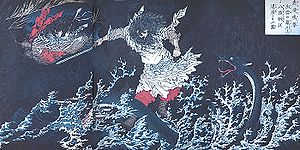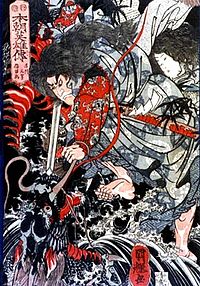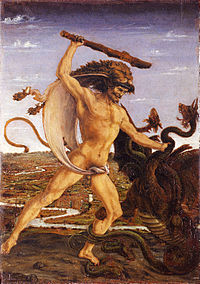- Yamata no Orochi
-
"Orochi" redirects here. For other uses, see Orochi (disambiguation).
 Susanoo slaying the Yamata no Orochi, by Toyohara Chikanobu
Susanoo slaying the Yamata no Orochi, by Toyohara Chikanobu
 Susanoo slaying the Yamata no Orochi, by Yoshitoshi
Susanoo slaying the Yamata no Orochi, by Yoshitoshi
 Susanoo slaying the Yamata no Orochi, by Kuniteru
Susanoo slaying the Yamata no Orochi, by Kuniteru
 Susanoo slaying the Yamata no Orochi, by Utagawa Kuniyoshi
Susanoo slaying the Yamata no Orochi, by Utagawa Kuniyoshi
Yamata no Orochi (八岐の大蛇, lit. "8-branched giant snake") or Orochi, translated as the Eight-Forked Serpent in English, is a legendary 8-headed and 8-tailed[1] [2] Japanese dragon that was slain by the Shinto storm-god Susanoo.
Contents
Mythology
Yamata no Orochi legends are originally recorded in two ancient texts about Japanese mythology and history. The ca. 680 AD Kojiki transcribes this dragon name as 八岐遠呂智 and ca. 720 AD Nihongi writes it as 八岐大蛇. In both versions of the Orochi myth, Susanoo or Susa-no-Ō is expelled from Heaven for tricking his sister Amaterasu the sun-goddess.
After expulsion from Heaven, Susanoo encounters two "Earthly Deities" (國神) near the head of the Hi River (簸川) in Izumo Province. They are weeping because they were forced to give the Orochi one of their daughters every year for seven years, and now they must sacrifice their eighth, Kushi-inada-hime (櫛名田比売 "comb/wondrous rice-field princess", who Susanoo transforms into a kushi 櫛 "comb" for safekeeping). The Kojiki tells the following version.
So, having been expelled, [His-Swift-impetuous-Male-Augustness] descended to a place [called] Tori-kami at the head-waters of the River Hi in the Land of Idzumo. At this time some chopsticks came floating down the stream. So His-Swift-Impetuous-Male-Augustness, thinking that there must be people at the head-waters of the river, went up it in quest of them, when he came upon an old man and an old woman, --two of them,--who had a young girl between them, and were weeping. Then he deigned to ask: "Who are ye?" So the old man replied, saying: "I am an Earthly Deity, child of the Deity Great-Mountain-Possessor. I am called by the name of Foot-Stroking-Elder, my wife is called by the name of Hand-Stroking Elder, and my daughter is called by the name of Wondrous-Inada-Princess." Again he asked: What is the cause of your crying?" [The old man answered] saying: "I had originally eight young girls as daughters. But the eight-forked serpent of Koshi has come every year and devoured [one], and it is now its time to come, wherefore we weep." Then he asked him: "What is its form like?" [The old man] answered, saying: "Its eyes are like akahagachi, it has one body with eight heads and eight tails. Moreover on its body grows moss, and also chamaecyparis and cryptomerias. Its length extends over eight valleys and eight hills, and if one look at its belly, it is all constantly bloody and inflamed." (What is called here akahagachi is the modern hohodzuki [winter-cherry]) Then His-Swift-Impetuous-Male-Augustness said to the old man: "If this be thy daughter, wilt thou offer her to me?" He replied, saying: "With reverence, but I know not thine august name." Then he replied, saying: "I am elder brother to the Heaven-Shining-Great-August-Deity. So I have now descended from Heaven." Then the Deities Foot-Stroker-Elder and Hand-Stroking-Elder said: "If that be so, with reverence will we offer [her to thee]." So His-Swift-Impetuous-Male-Augustness, at once taking and changing the young girl into a multitudinous and close-toothed comb which he stuck into his august hair-bunch, said to the Deities Foot-Stroking-Elder and Hand-Stroking-Elder: "Do you distill some eight-fold refined liquor. Also make a fence round about, in that fence make eight gates, at each gate tie [together] eight platforms, on each platform put a liquor-vat, and into each vat pour the eight-fold refined liquor, and wait." So as they waited after having thus prepared everything in accordance with his bidding, the eight-forked serpent came truly as [the old man] had said, and immediately dipped a head into each vat, and drank the liquor. Thereupon it was intoxicated with drinking, and all [the heads] lay down and slept. Then His-Swift-Impetuous-Male-Augustness drew the ten-grasp sabre, that was augustly girded on him, and cut the serpent in pieces, so that the River Hi flowed on changed into a river of blood. So when he cut the middle tail, the edge of his august sword broke. Then, thinking it strange, he thrust into and split [the flesh] with the point of his august sword and looked, and there was a great sword [within]. So he took this great sword, and, thinking it a strange thing, he respectfully informed the Heaven-Shining-Great-August-Deity. This is the Herb-Quelling Great Sword. (tr. Chamberlain 1919:71-3)
Compare the Nihongi description of the Yamata no Orochi (tr. Aston 1896:1:52-53). "It had an eight-forked head and an eight-forked tail; its eyes were red, like the winter-cherry; and on its back firs and cypresses were growing. As it crawled it extended over a space of eight hills and eight valleys." These botanical names used to describe this Orochi are akahagachi or hoozuki ("winter cherry or Japanese lantern, Physalis alkekengi"), hikage ("club moss, Lycopodiopsida), hinoki ("Japanese cypress, Chamaecyparis obtusa), and sugi ("Japanese cedar, Cryptomeria").
This legendary sword Kusanagi-no-Tsurugi, along with the Yata no Kagami mirror and Yasakani no Magatama jewel or orb, are the three sacred Imperial Regalia of Japan.
Etymology
The Japanese name orochi 大蛇 derives from Old Japanese woröti (with a regular o- from wo- shift, Miller 1971:25-7), but its etymology is enigmatic. Besides this ancient orochi reading, the kanji 大蛇 are commonly pronounced daija "big snake; large serpent".
Carr (1990:169) notes that Japanese scholars have proposed "more than a dozen" orochi < woröti etymologies, while Western linguists have suggested loanwords from Austronesian, Tungusic, and Indo-European languages. The most feasible native etymological proposals are Japanese o- from o 尾 "tail" (which is where Susanoo discovered the sacred sword), ō 大 "big; great", or oro 峰 "peak; summit"; and -chi meaning "god; spirit", cognate with the mizuchi river-dragon. Benedict (1985:167) originally proposed woröti "large snake" was suffixed from Proto-Austro-Japanese *(w)oröt-i acquired from Austronesian *[q]uḷəj "snake; worm"; which he later (1990:243) modified to *(u-)orot-i from *[q,ʔ]oḷəj. Miller (1987:647) criticized Benedict for overlooking Old Japanese "worö 'tail' + suffix -ti — as well as an obvious Tungus etymology, [Proto-Tungus] *xürgü-či 'the tailed one'", and notes "this apparently well-traveled orochi has now turned up in the speculation of the [Indo-European] folklorists (Littleton 1981)." Littleton's hypothesis involves the 3-headed monster Trisiras or Viśvarūpa, which has a mythological parallel because Indra killed it after giving it soma, wine, and food, but lacks a phonological connection.
Mythological parallels
Polycephalic or multi-headed animals are rare in biology but common in mythology and heraldry. Multi-headed dragons, like the 8-headed Orochi and 3-headed Trisiras above, are a common motif in comparative mythology. For instance, multi-headed dragons in Greek mythology include the wind-god Typhon who had several polycephalic offspring, including the 9-headed Lernaean Hydra and the 100-headed Ladon, both slain by Hercules.
Two other Japanese examples derive from Buddhist importations of Indian dragon myths. Benzaiten, the Japanese name of Saraswati, supposedly killed a 5-headed dragon at Enoshima in 552 AD. Kuzuryū 九頭龍 "9-headed dragon", deriving from the Nagaraja snake-kings Vasuki and Shesha, is worshipped at Togakushi Shrine in Nagano Prefecture. (Compare the Jiutouniao 九頭鳥 "nine-headed bird" in Chinese mythology.)
Comparing folklore about polycephalic dragons and serpents, 8-headed creatures are less common than 7- or 9-headed ones. Among Japanese numerals, ya or hachi 八 can mean "many; varied" (e.g., yaoya 八百屋 [lit. "800 store"] "greengrocer; jack-of-all-trades"). De Visser (1913:150) says the number 8 is "stereotypical" in legends about kings or gods riding dragons or having their carriages drawn by them. Smith (1919:212), who quotes the orochi myth with "seven or eight heads" and compares a Celtic dragon, says, "The seven-headed dragon is found also in the Scottish dragon-myth, and the legends of Cambodia, India, Persia, Western Asia, East Africa, and the Mediterranean area." Smith (1919:215) identifies the mythic 7- or 8-headed dragons with the 7-spiked Pteria spider shell or 8-tentacled octopus.
The myth of a Storm God fighting a Sea Serpent is itself a popular mythic trope potentially originating with the Proto-Indo-European religion[3] and later transmitted into the religions of the Ancient Near East most likely initially through interaction with Hittite speaking peoples into Syria and the Fertile Crescent.[4] This motif, known as chaoskampf (German for "struggle against chaos") represents the clash between order and chaos. Often as these myths evolve from their original source, the role of the storm god (himself often the head of a pantheon) is adopted by culture heroes or a personage symbolizing royalty. A non-inclusive list of mythological parallels to the story of Susanoo vs. Orochi include:
Indo-European
- Thor vs. Jörmungandr (Norse)
- Tarhunt vs. Illuyanka (Hittite)
- Zeus vs. Typhon (Greek)
- Hercules vs. The Lernaean Hydra (Greek)
- Indra vs. Vritra (Vedic)
- Θraētaona vs. Aži Dahāka (Zorastrian)
- Dobrynya Nikitich vs. Zmey Gorynych (Slavic)
- Saint George vs. The Dragon (Christian)
- Făt-Frumos vs. Balaur (Romanian)
Afro-Asiatic
- Baʿal vs. Yam (Canaanite)
- Marduk vs. Tiamat (Babylonian)
- Atum vs. Nehebkau (Egyptian)
- Yahweh vs. Leviathan (Jewish)
In many of these examples, the serpent god is often seen as multi-headed or multi-tailed.
In popular culture
- Orochi appears in the 1959 Japanese film The Three Treasures. This is one of the first depictions to give Orochi a variety of elemental powers, mostly associated with individual heads.
- Orochi appears in the 1963 animated film The Little Prince and the Eight-Headed Dragon
- Orochi also appears in the 1994 remake Orochi, the Eight-Headed Dragon.
- Orochi appears in the 1985 fan film Yamata no Orochi no Gyakushū.
- In the 2001 film Godzilla, Mothra and King Ghidorah: Giant Monsters All-Out Attack, King Ghidorah, the archnemesis of Godzilla, is alluded to being an immature Orochi.
- In the 2001 animated series Digimon Tamers there is an evil Digimon called Orochimon based on the legendary monster. It attempted to kidnap Jeri Kato for use as a servant, tasking her with feeding it endless quantities of wine (milkshakes in the dubbed version). Unlike the mythological Orochi, it actually gained strength from its drinking, although Jeri attempts to overfeed it in hopes of making it drowsy. It also seems to have only one "true" head-all the others appear to be mechanical. Instead of elemental powers, Orochimon displayed the ability to regenerate its heads when they were destroyed.
- In the 2002 animated series Digimon Frontier there is a digimon called Susanoomon with a weapons system called the ZERO-ARMS: Orochi
- In 2004-2005, Orochi appeared as a recurring enemy in the Manga series (and its Anime adaptation) Priestesses of the Godless Month.
- Orochi appeared as a recurring boss in the 2006 Capcom game Ōkami. It is a massive dragon-like demon that was sealed away centuries ago by the legendary Nagi, assisted by the sun goddess, Shiranui. When Nagi's descendant, Susano, removes the sword binding Orochi, the monster is released to wreak havoc on the surrounding lands. It is up to the diminished Shiranui - now called Amaterasu - to stop Orochi in a battle that calls parallels to the original legend (namely, the role of Susano and the use of sake to weaken the beast).
- The character Ryu in the Manga series Shaman King harnessed the power of Yamata no Orochi through his guardian ghost Tokagero, several times throughout the series.
- In the SNK Playmore game series King of Fighters Orochi is a Devil God sealed centuries ago by three families, the Kusanagi (reference to the Kusanagi no Tsurugi, the Yata (reference to the Yata no Kagami) and the Yasakani (later on called the Yagami, and a reference to the Yasakani no Magatama) who appears in the 1997 edition as the final boss. As a tribute, during the character's animation previous to the combat he shows 8 arms around him.
- In the Yu-gi-oh! trading card game, a card known as Yamata Dragon is based on this beast.
- It appeared in the video game King of Fighters as a main antagonist
- In Koei's Warriors Orochi series he is the main antagonist accompanied by Da Ji and Kiyomori Taira.
- The Pokémon Hydreigon is based on Yamata no Orochi.[5]
- Orochi is also referenced in the Naruto and Naruto: Shippuden series as one of the series' main antagonists, Orochimaru. As his techniques usually involve snakes. Also, Orochimaru was eventually defeated by a technique called Susanoo, influenced by the story of Yamata no Orochi's death by the hands of Susanoo
- Orochi also appears in Rave Master (manga) when the main character Haru Glory enters one of the enemies battleships, and Orochi is one of the gatekeepers
- In the famous Facebook game Ninja Saga, Yamata no Orochi is the target of the 4th part of the Jounin Exams.
- An original Xbox Japanese game, Magatama, Orochi is Shinado (the main character)'s "Pet". It accompany him throughout his demon-slaying journey and act as Shinado's Long range weapon.
- Orochi figures prominently into the story of the 2011 anime movie Legend of the Millenium Dragon.
References
- ^ 日本書紀 卷第一, 頭尾各有八岐
- ^ 古事記 上卷并序, 身一有八頭八尾
- ^ Watkins, Calvert (1995). How to Kill a Dragon: Aspects of Indo-European Poetics. London: Oxford University Press. ISBN 978-0195144130
- ^ Speiser, "An Intrusive Hurro-Hittite Myth", Journal of the American Oriental Society 62.2 (June 1942:98–102) p. 100
- ^ Nintendo Dream Vol.205
- Aston, William George, tr. 1896. Nihongi: Chronicles of Japan from the Earliest Times to A.D. 697. 2 vols. Kegan Paul. 1972 Tuttle reprint.
- Benedict, Paul K. 1985. "Toppakō: Tōnan Ajia no gengo kara Nihongo e 突破口等東南アジアの言語から日本語え," Nishi Yoshio 西義郎, tr. Computational Analyses of Asian and African Languages 25.
- Benedict, Paul K. 1990. Japanese Austro/Tai. Karoma.
- Carr, Michael. 1990. "Chinese Dragon Names", Linguistics of the Tibeto-Burman Area 13.2:87-189.
- Chamberlain, Basil H., tr. 1919. The Kojiki, Records of Ancient Matters. 1981 Tuttle reprint.
- Littleton, C. Scott. 1981. "Susa-nö-wo versus Ya-mata nö woröti: An Indo-European Theme in Japanese Mythology." History of Religions 20:269-80.
- Miller, Roy Andrew. 1971. Japanese and the Other Altaic Languages. University of Chicago Press.
- Miller, Roy Andrew. 1987. "[Review of] Toppakō: Tōnan Ajia no gengo kara Nihongo e … By Paul K. Benedict. Translated by Nishi Yoshio." Language 63.3:643-648.
- Smith, G. Elliot. 1919. The Evolution of the Dragon. London: Longmans, Green & Company.
- Visser, Marinus Willern de. 1913. The Dragon in China and Japan. J. Müller.
External links
- Yamata-no-orochi, Encyclopedia of Shinto
- Hyakkai Ryūran: Yamata-No-Orochi (Japanese)
Japanese mythology Mythic texts Kojiki | Nihon Shoki | Fudoki | Kujiki | Kogo Shūi | Hotsuma Tsutae | Nihon Ryōiki | Konjaku Monogatarishū | Shintōshū

Japanese creation myth Takamagahara mythology Izumo mythology Yamata no Orochi | Hare of Inaba | ŌkuninushiHyuga mythology Human age Emperor Jimmu | Tagishimimi | Kesshi HachidaiMythical locations Major Buddhist figures Amida Nyorai | Daruma | Five Wisdom BuddhasSeven Lucky Gods Shinto deities | Japanese deities | Sacred objects | Japanese religions Categories:- Japanese dragons
- Japanese folklore
- Japanese legendary creatures
- Japanese mythology
- Legendary serpents
Wikimedia Foundation. 2010.

